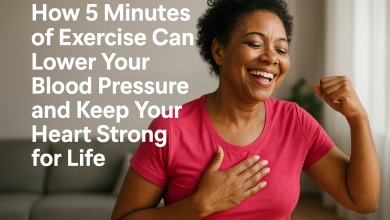5 Weird Wellness Habits Experts Swear By—Yes, Even Humming!

In today’s fast-paced world, wellness trends come and go faster than ever. Every few months, a new “miracle habit” takes over social media—some backed by science, others… not so much. But what if some of the strangest wellness habits are actually the most effective?
Believe it or not, many health and wellness experts—nutritionists, psychologists, physiologists, sleep specialists, and even ENT doctors—recommend quirky, unusual, and downright weird habits to improve everything from stress levels to metabolism to emotional health.
And yes… one of those habits includes humming.
Here are five weird wellness habits experts swear by. They may sound strange, but they’re backed by science, practiced by professionals, and could make a surprisingly big difference in your physical and mental well-being.
1. Humming for Nervous System Calm & Sinus Health
You’ve probably hummed along to music without thinking twice, but experts say humming intentionally may be a powerful wellness tool.
Why Humming Works
Humming stimulates the vagus nerve, the body’s longest cranial nerve, which plays a major role in regulating stress, mood, digestion, inflammation, and heart rate. When activated, the vagus nerve puts your body into “rest and digest” mode instead of “fight or flight.”
Humming creates deep, low-frequency vibrations that travel through the chest, throat, face, and head—sending a calming signal to the nervous system.
Benefits of Humming Backed by Science
✔ Reduces stress and anxiety: Humming boosts parasympathetic activity and lowers cortisol levels.
✔ Improves sinus and nasal health: It increases nitric oxide production in the nasal passages, which enhances airflow and reduces inflammation.
✔ Improves sleep and relaxation: A few minutes of humming before bed helps the brain transition to a calmer state.
✔ Supports heart health: Studies link humming-induced vagal stimulation with improved heart rate variability (HRV).
How to Do It
- Sit comfortably and inhale deeply through the nose.
- On the exhale, hum softly for 5–10 seconds.
- Focus on the feeling of vibration.
- Repeat for 2–5 minutes.
Some therapists recommend the “Bee Breath” (Bhramari Pranayama), a yogic technique where you hum with your ears closed using your fingers—boosting the vibrational effect.
Why Experts Love It
Because it’s free, simple, and instantly calming.
Psychologists use it for anxiety, yoga instructors use it for breath therapy, ENT doctors use it for sinus health, and sleep experts recommend it for bedtime relaxation.
2. Walking Backward to Improve Brain Function & Body Alignment
Yes… walking backward.
Also called retro-walking, this unusual habit has been recommended by physiotherapists, sports scientists, and even neurologists.
Why Walking Backward Works
When you walk backward, your brain and muscles work differently. It challenges your coordination, strengthens underdeveloped muscles, and even enhances cognitive processing.
Benefits Supported by Research
✔ Boosts memory and cognitive performance: Researchers found that moving backward—especially physically—can improve short-term memory recall and focus.
✔ Improves posture and body alignment: It reduces the load on knees and strengthens muscles in the legs and core that forward-walking often neglects.
✔ Helps with knee pain: Physiotherapists use backward walking to reduce pressure on the patella and improve gait.
✔ Burns more calories than forward walking: Studies show 30% greater energy expenditure.
How to Do It Safely
- Start on a flat, open surface (like a park trail or gym track).
- Move slowly and keep your hands slightly raised at your sides.
- Keep short steps to avoid imbalance.
- Advanced version: try on a treadmill at slow speed while holding rails.
Why Experts Recommend It
Backward walking is a low-impact way to dramatically improve mobility, balance, and neuromuscular coordination. It’s especially useful for people with knee pain, posture issues, or anyone wanting a quick cognitive boost.
3. Cold Face Dunking to Reset Stress and Boost Mood
Cold plunges may get all the attention, but many wellness experts—including psychologists and breathwork specialists—swear by a simpler, colder, and much easier practice:
Cold face dunking.
The technique involves submerging your face in a bowl of icy water for 10–20 seconds.
What Happens in Your Body
Cold exposure triggers the mammalian dive reflex, which immediately:
- Slows down the heart rate
- Lowers blood pressure
- Activates the parasympathetic nervous system
- Reduces stress response
- Increases circulation
- Decreases inflammation
This is why even people with panic attacks use cold water on the face for immediate grounding.
Benefits Backed by Experts
✔ Instant anxiety relief: The sudden drop in heart rate physically interrupts panic and anxiety cycles.
✔ Improved skin health: The cold constricts pores and reduces inflammation.
✔ Better focus and alertness: Cold exposure increases norepinephrine, the alertness hormone.
✔ Reduced puffiness and under-eye swelling: Popular among dermatologists and estheticians.
How to Do It Safely
- Fill a bowl with cold water and add ice.
- Hold your breath, then dunk your face for 10–15 seconds.
- Repeat 2–3 times if desired.
Not recommended for people with heart conditions or extreme cold sensitivity.
Why Experts Swear By It
It’s one of the fastest, most reliable ways to switch your nervous system from stress-mode to calm-mode. Unlike whole-body cold plunges, face dunking is easier and safer for most people.
4. Mouth Taping at Night for Better Sleep, Breathing & Energy
This one may sound controversial, but sleep doctors and breathwork specialists often highlight the surprising benefits of mouth taping—a technique where you tape your lips closed at night to encourage nasal breathing.
Before you panic: it’s not about sealing your mouth shut completely. Instead, gentle, breathable tape is used to help keep the lips closed naturally.
Why Nasal Breathing Matters
Nasal breathing:
- Filters and humidifies air
- Regulates breathing volume
- Prevents mouth dryness
- Reduces snoring
- Supports nitric oxide production
- Improves oxygen absorption
- Helps prevent sleep disruptions
Mouth breathing, on the other hand, is linked to:
- Poor sleep quality
- Low energy
- Snoring
- Dry mouth
- Anxiety
- Inflammation
Benefits of Mouth Taping
According to sleep experts and breathwork coaches:
✔ Improves sleep quality
✔ Reduces snoring
✔ Boosts morning energy levels
✔ Promotes calmness and reduces nighttime stress
✔ Enhances athletic performance by improving airway efficiency
✔ May reduce sleep apnea symptoms (with professional supervision)
How to Do It Safely
- Use special mouth tapes designed for sleep (not regular tape!).
- Apply vertically, not horizontally, allowing space for airflow.
- Never use mouth tape if you have nasal congestion, severe apnea, or breathing issues.
Why Experts Recommend It
It’s simple, affordable, and can dramatically improve sleep within a few nights. Even some pediatric dentists recommend nasal breathing training (not taping) for children with mouth breathing habits.
5. Earthing (Barefoot Grounding) to Reduce Inflammation and Improve Mood
Earthing—or grounding—sounds like something a hippie might recommend… but surprisingly, many integrative physicians, functional medicine practitioners, and even cardiologists support it.
The idea is simple: walk barefoot on natural ground (grass, soil, sand) to reconnect with the Earth’s electrical field.
How Earthing Works
Your body accumulates positive charges (free radicals) through stress, pollution, electronics, and inflammation. The Earth carries a natural negative charge.
When you walk barefoot on natural surfaces, electrons flow into your body, neutralizing excess positive charges.
Think of it like “resetting” your internal electrical system.
Benefits Backed by Emerging Research
✔ Reduces inflammation
✔ Improves sleep and circadian rhythm
✔ Enhances mood and reduces stress
✔ Supports immune function
✔ Improves recovery in athletes
✔ May reduce chronic pain
Some studies show measurable changes in cortisol levels and blood viscosity after regular grounding practices.
How to Practice Earthing
- Walk barefoot for 10–20 minutes daily.
- Best surfaces: grass, sand, soil.
- Avoid concrete or asphalt—they don’t conduct the Earth’s electrical charge.
Why Experts Support It
It’s a free habit with low risk and growing evidence behind its physiological effects. Even if some benefits come from being outdoors, sunlight, and relaxation, grounding remains a simple, effective wellness habit.
Putting It All Together: Why Weird Wellness Habits Actually Work
Many of these habits work because they directly influence core systems in your body:
✔ The Vagus Nerve
Activated by humming, cold face dunking, breathwork, and nasal breathing.
✔ The Nervous System
Calmed by grounding, humming, cold exposure, and improved breathing.
✔ Posture and Body Alignment
Addressed by backward walking.
✔ Inflammation and Stress Hormones
Reduced through grounding, nasal breathing, and humming.
✔ Metabolic Efficiency and Lung Function
Improved by nasal breathing and breath-based habits.
✔ Cognitive Function
Boosted through backward walking and breath control.
These habits seem strange at first, but they’re rooted in physiology, not superstition.
Which Weird Wellness Habit Should You Start With?
If you’re new to these practices, here’s an easy guide:
For Stress Relief → Start with Humming
It’s instant, safe, and surprisingly pleasant.
For Better Sleep → Try Nasal Breathing (with or without tape)
Even switching to nasal breathing during the day helps.
For Energy & Mood → Cold Face Dunking
Just 10 seconds can shift your state.
For Physical Health → Practice Backward Walking
Begin with a few minutes a day.
For Holistic Wellness → Try Grounding
Spend time barefoot outdoors.
Final Thoughts
Wellness doesn’t always come from expensive supplements, gym memberships, or high-tech gadgets. Sometimes, the most powerful tools are free, natural, and surprisingly weird.
Humming. Walking backward. Dunking your face in cold water. Taping your mouth. Walking barefoot.
These habits might look strange from the outside—but experts love them because they work.
Try one today. You might be surprised at how much better you feel.




